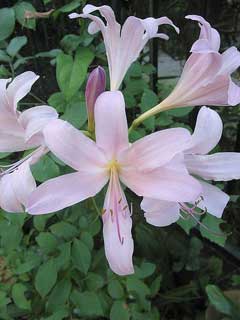 |
|
http://commons.wikimedia.org/wiki/User:Sphl |
 |
| http://commons.wikimedia.org/wiki/User:Sphl |
Translate this page:
Summary
Bloom Color: Pink. Main Bloom Time: Early fall, Late summer. Form: Upright or erect.
Physical Characteristics

 Lycoris squamigera is a BULB growing to 0.7 m (2ft 4in) by 0.2 m (0ft 8in) at a slow rate.
Lycoris squamigera is a BULB growing to 0.7 m (2ft 4in) by 0.2 m (0ft 8in) at a slow rate.
See above for USDA hardiness. It is hardy to UK zone 5. It is in flower from August to September. The species is hermaphrodite (has both male and female organs).
Suitable for: light (sandy) and medium (loamy) soils and prefers well-drained soil. Suitable pH: mildly acid, neutral and basic (mildly alkaline) soils. It cannot grow in the shade. It prefers moist soil.
UK Hardiness Map
US Hardiness Map
Synonyms
Plant Habitats
South Wall. By.
Edible Uses
Edible Parts: Root
Edible Uses:
Bulb - cooked. It is used as a source of starch[105, 177]. The bulb is 4cm in diameter[200]. Caution is advised, see the notes above on toxicity.
References More on Edible Uses
Medicinal Uses
Plants For A Future can not take any responsibility for any adverse effects from the use of plants. Always seek advice from a professional before using a plant medicinally.
None known
References More on Medicinal Uses
The Bookshop: Edible Plant Books
Our Latest books on Perennial Plants For Food Forests and Permaculture Gardens in paperback or digital formats.

Edible Tropical Plants
Food Forest Plants for Hotter Conditions: 250+ Plants For Tropical Food Forests & Permaculture Gardens.
More

Edible Temperate Plants
Plants for Your Food Forest: 500 Plants for Temperate Food Forests & Permaculture Gardens.
More

More Books
PFAF have eight books available in paperback and digital formats. Browse the shop for more information.
Shop Now
Other Uses
References More on Other Uses
Cultivation details
Landscape Uses:Border, Container, Foundation, Massing, Rock garden, Seashore, Specimen. Requires a deep well-drained sandy soil rich in organic matter in full sun[200]. The bulb should be planted quite shallowly so that it can ripen well after flowering[245]. Hardy to at least -15°c, the leaves are produced in early spring and persist until late summer[200]. Plants need a warm period in late summer in order to ripen the bulbs and induce flowering in the following year[188]. A very ornamental species, each bulb producing a number of flowering stems in mid to late summer[245]. The flowers are very sweetly scented, the scent pervading the whole garden[245]. Plants are attractive to slugs and need to be protected from them[200]. Very sensitive to root disturbance, the bulbs can take some years to become well established[200]. Special Features:Not North American native, Naturalizing, Suitable for cut flowers, Fragrant flowers, Attractive flowers or blooms.
References Carbon Farming Information and Carbon Sequestration Information
Temperature Converter
Type a value in the Celsius field to convert the value to Fahrenheit:
Fahrenheit:
The PFAF Bookshop
Plants For A Future have a number of books available in paperback and digital form. Book titles include Edible Plants, Edible Perennials, Edible Trees,Edible Shrubs, Woodland Gardening, and Temperate Food Forest Plants. Our new book is Food Forest Plants For Hotter Conditions (Tropical and Sub-Tropical).
Shop Now
Plant Propagation
The seed is best sown as soon as it is ripe in a greenhouse and should germinate in the spring[200]. Sow the seed thinly so that it does not need to be disturbed for its first year of growth. Give an occasional liquid feed during the growing season to ensure the plants do not become nutrient deficient. Pot up the small bulbs when the plants become dormant, placing 2 bulbs in each pot. Grow them on for another 2 years in the greenhouse before planting them out when they are dormant. Division of offsets in the dormant season[200].
Other Names
If available other names are mentioned here
Native Range
TEMPERATE ASIA: China (Jiangsu Sheng, Shandong Sheng, Zhejiang Sheng), Japan (Honshu, Kyushu, Shikoku), Korea, South
Weed Potential
Right plant wrong place. We are currently updating this section.
Please note that a plant may be invasive in one area but may not in your area so it's worth checking.
Conservation Status
IUCN Red List of Threatened Plants Status :

Growth: S = slow M = medium F = fast. Soil: L = light (sandy) M = medium H = heavy (clay). pH: A = acid N = neutral B = basic (alkaline). Shade: F = full shade S = semi-shade N = no shade. Moisture: D = dry M = Moist We = wet Wa = water.
Now available:
Food Forest Plants for Mediterranean Conditions
350+ Perennial Plants For Mediterranean and Drier Food Forests and Permaculture Gardens.
[Paperback and eBook]
This is the third in Plants For A Future's series of plant guides for food forests tailored to
specific climate zones. Following volumes on temperate and tropical ecosystems, this book focuses
on species suited to Mediterranean conditions—regions with hot, dry summers and cool, wet winters,
often facing the added challenge of climate change.
Read More
Expert comment
Author
Maxim.
Botanical References
58200
Links / References
For a list of references used on this page please go here
Readers comment
© 2010, Plants For A Future. Plants For A Future is a charitable company limited by guarantee, registered in England and Wales. Charity No. 1057719, Company No. 3204567.